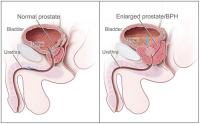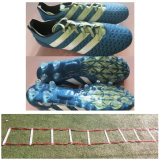PURPOSE This study investigates the impact of injury experience on ankle dorsiflexion, quadriceps extensibility, and dynamic stability in elite adolescent and adult volleyball players. METHODS A total of 485 players (adolescents=337, adults=115) reported lower extremities injuries, with measurements taken for ankle dorsiflexion and quadriceps extensibility using the weight- bearing lunge test and Ely’s test, respectively. The Y-balance test was used for dynamic stability. Measurements were conducted on the injured leg of players with knee and/or ankle injuries and the dominant leg of healthy players. Four groups were classified based on injury experience, and comparisons were made between both legs. Additionally, the variables of adolescent players were compared to those of adults. RESULTS Adolescent players with knee injuries exhibited a larger difference in ankle dorsiflexion between both legs, while adult players with ankle injuries demonstrated an asymmetry of ankle dorsiflexion. Regardless of age, players with knee or ankle injuries displayed lower dynamic stability compared to healthy players. Notably, adults with knee injuries showed a larger difference in dynamic stability between both legs. CONCLUSIONS To prevent and rehabilitate volleyball-related injuries, comprehensive injury risk factors, including age, should be managed in the injury prevention strategies.
PURPOSE This study aimed to identify the lower limb muscle activity based on direction prediction presence or absence and gender during side cutting in healthy college students. METHODS The study participants included 14 healthy males and females (8 males; 6 females). All participants ran at full speed for a distance of 12m, and side-cutting was carried out at 45 degrees in a randomly indicated direction and in a fixed direction. Simultaneously, data regarding vastus medialis, vastus lateralis, semitendinosus, and biceps femoris muscle activity of the dominant leg were collected using an electromyography sensor, and data regarding vertical acceleration were collected using an inertial sensor attached to the pelvis. A sync webcam was used for obtaining the initial contact of side cutting and the stance period time. During the 10 milliseconds (pre-activation) prior to the initial contact and 50% of the stance phase (loading phase), vastus medialis, vastus lateralis, semitendinosus, and biceps femoris average muscle activity and hamstring to quadriceps ratio included as variables. RESULTS During the pre-activation and loading phase, the vastus medialis muscle activity of the male group was higher in the unexpected condition than in the expected condition. Furthermore, hamstring to quadriceps ratio was confirmed to be lower under unexpected condition compared to under expected condition during on loading phase. CONCLUSIONS The study results suggest that the risk of anterior cruciate ligament injury may increase with side cutting under unpredictable conditions. It is expected to provide useful information for identifying factors related to knee injury in the general population.
PURPOSE This study aimed to a) develop suitable screening tools for identifying gambling severity in Korea and b) explore factors that affect the gambling severity index in order to prevent Korean sports betting users from easily falling into gambling addiction, thus providing practical and useful guidelines in this regard. METHODS This study examined Korean sports fans who had experiences of participating in sports betting (Sports Toto), a legal sports betting system in Korea. Toward this end, an online survey was conducted from May 10 to June 25, 2022. A total of 214 questionnaire results, excluding 23 who gave insincere and/or incomplete answers, were analyzed for normal distribution through skewness and kurtosis, and subscale scores were calculated after performing exploratory factor analysis and reliability analysis using Cronbach’s α. RESULTS A psychological gambling severity index and behavioral gambling severity index were developed based on a stepwise regression analysis, which was conducted using the demographic characteristics of domestic sports betting participants and their lifestyle habits (e.g., smoking and drinking, problem gambling severity index, self-control scale, and gambling expectation scale). CONCLUSIONS First, factors affecting the psychological gambling severity index were identified (having a job, job stability, and security) along with lifestyle habits (smoking and drinking). Second, gender, occupational characteristics, full-time employment, confidence in self-control, and desire for self-improvement were indicated as significant factors that influenced the behavioral gambling severity index.
PURPOSE The purpose of this review was to summarize the current knowledge on the trends in athletes’ health problems (and their preventive strategies) caused by low energy availability (LEA) and relative energy deficiency in sports (RED-S). METHODS In this narrative review, we summarized previous studies by searching the literature in the PubMed, Google Scholar, and Science Direct databases. RESULTS Energy availability (EA) refers to the amount of energy from caloric intake used for exercise, and a LEA is considered as a surrogate marker of RED-S. In several previous studies, chronic low energy availability in female athletes has been reported to cause health problems such as endocrine dysfunctions, immunosuppression, and psychological disorders, and to also affect the hypothalamic-pituitary-gonadal (HPC) axis and bone health. Moreover, it has been suggested that an increase in injury risk and a decrease in exercise performance may occur. CONCLUSIONS Since it can be difficult to recover from the health deteriorations caused by RED-S, early detection (of related signs and symptoms) and prevention are very important. Therefore, athletes, coaches, and parents need to develop educational programs that ease the recognition of the problems caused by various symptoms related to RED-S and promote educational interventions.

Purpose Prostate problems, such as prostate cancer, and benign prostate hyperplasia have been recognized as problems largely related to androgens and genetic factors. They affect a large fraction of the elderly population, contributing significantly to morbidity and mortality. Therefore, the purpose of this review paper was to investigate a therapeutic strategies for prostate cancer and benign prostate hyperplasia. Methods In order to determine the therapeutic exercise strategies for prostate cancer and benign prostate hyperplasia, previous literature was reviewed with MEDLINE, PubMed, and Scopus databases. Results Prostate cancer and its associated treatments can cause significant and lasting morbidities, such as cardiovascular and sexual dysfunctions. Various interventions have attempted to prevent or mitigate these dysfunctions. This review summarizes the available evidence concerning the effects of exercise training on male sexual health in the cancer prevalent population. Smoking cessation, regular exercise, and maintaining healthy weight are important public health targets for intervention. Importantly, several lifestyle modifications may lower the risk of developing more aggressive cancer or offer survival benefits to prostate cancer patients. Conclusions In this review article, physical exercise training can increase apoptosis markers in the prostate, suggesting exercise training as a potential novel therapeutic strategies for treating prostate cancer and benign prostate hyperplasia. Future studies in more advanced and varied prostate cancer populations are required to ascertain the duration, intensity and frequency of exercise that optimizes the effects of exercise training on prostate cancer and benign prostate hyperplasia.


Purpose The purpose of this study was to investigate the lower extremity muscles activity during forward side step by soccer field ground types. Methods Fifteen elite high school soccer players participated in this study. Muscle activation patterns were recorded at 2000 Hz during forward side step task. Surface EMG of the tibialis anterior(TA), soleus(SOL), medial gastrocnemius(MG), lateral gastrocnemius(LG), peroneus brevis(PB) muscle was recorded, and the root mean square of the EMG was normalized, using a maximum voluntary isometric contraction(%MVIC). One-way repeated ANOVA was used for comparison among three soccer field ground types(natural grass, artificial turf, hard ground). Results Artificial turf displayed greater soleus and peroneus brevis activities compare to natural grass during forward side step task. Conclusions The relationship between increased soleus and peroneus brevis activation and greater incidence of injury in artificial turf versus natural grass requires further study. Soccer players routinely training on artificial turf for prolonged periods should be carefully monitored.



Purpose The purpose of this study was to investigate the changes of gait patterns and muscle activations according to dual tasks during stair ascending. Methods Twelve sedentary young male adults(Age: 27.0±1.8 yrs, Weight: 65.8±9.9 kg) without any lower extremity injuries participated in the study. Participants performed stair walking up 7 floors and their ascending motion on each floor was analyzed according to dual tasks. A wireless electromyography (EMG) were attached on the Rectus Femoris(RF), Biceps Femoris(BF), Gastrocnemius(GN), Tibialis Anterior(TA) muscle to calculate integrated EMG(iEMG) and co-contraction index(CI). Chest and left heel accelerometer signal were recorded by wireless accelerometer and those were used to calculate approximate entropy(ApEn) for analyzing gait pattern. All analyses were performed with SPSS 21.0 and for repeated measured ANOVA and Post-hoc was LSD. Results The results of this study indicated that dual task appeared to increase their time, CI and there were a statistically significant difference in most muscle on each floors compared to the non dual tasks. Also, ApEn were a statistically significant difference in only left and right direction than non dual task. Subjects showed more irregular pattern and instability muscle activation response during dual tasks. Conclusion Because there are many dangers often use of stairs in everyday life, in the future, we have to make a lot of efforts to prevent fall.


Frailty in older adults is related to an increased risk for poor health outcomes including falls, disability, hospitalization and mortality. The purpose of this study was to determine the thresholds of a functional fitness associated with frailty for community-dwelling woman aged 65 or older. In this study, the National Fitness Award(NFA) items for elderly were utilized as the physical function and fitness testing for korean elderly women. The total of 444 community-dwelling woman completed the testings. Frailty status was classified by the Japan LTCI system ‘Kihon Checklist’ in the study. The prevalence of the frailty was 19.1% in the study. The frail elderly were older and showed higher obesity index such as weight, body mass index (BMI), percent body fat and waist circumference than the normal elderly. After adjusting for age and BMI which was related to frailty, fitness testing items were compared depending on frailty. As the result, the frail elderly showed significantly lower fitness levels in grip strength, 30-second chair stand test, timed up and go, figure-of-8 walk around two cones, and 2-minute step test than the normal elderly. When the fitness cut-off values were analyzed using the ROC curve, also, grip strength: 34.13%, 30-second chair stand test: 14 reps, timed up and go: 7.09 seconds, figure-of-8 walk around two cones: 30.88 seconds, and 2-minute step test: 93 reps. In addition, based on the cut-off values of each fitness item, the group with a low fitness level showed a 1.86 to 3.09 higher odds ratio of frailty than the group with a high fitness level, even after age and BMI were adjusted. In conclusion, these findings indicate that the fitness cut-off values in this study are fitness levels for preventing frailty of Korean elderly women and there will be a need for a large-scale study including subdivided fitness cut-off values for each age group and targets elderly men as well.
PURPOSE This study examined levels of safety knowledge and practice among recreational sports participants, focusing particularly on impacts of gender, age, injury experience, and exercise-level profile. In sports environments, understanding these factors is essential for developing targeted strategies to promote safe behaviors. METHODS Survey data from 7725 participants engaged in regular recreational sports activities were analyzed. Latent Profile Analysis was employed to categorize participants based on their injury experience and exercise levels, resulting in two profiles: Group 1 (moderate or severe injury experience with intermediate exercise levels) and Group 2 (mild injury experience with beginner exercise levels). Three-way ANOVA was then used to evaluate relationships between these profiles and safety knowledge and practice levels. RESULTS Results revealed significant differences across sex, age, and profile groups. Compared with women, men demonstrated higher levels of safety knowledge and practice, which were likely influenced by greater exposure to high-intensity sports and risk-taking tendencies. Adolescents exhibited the highest levels of safety knowledge and practice linked to structured safety education, but these levels declined in early adulthood and then increased again in middle age due to growing health awareness and preventive motivations. Furthermore, participants in Group 1 consistently showed higher levels of safety knowledge and practice than those in Group 2, highlighting injury experience’s role in shaping safety behaviors. CONCLUSIONS These findings underscore the importance of developing gender-specific safety education programs, age-appropriate interventions, and training initiatives tailored to beginning participants. Future research should evaluate these strategies’ long-term impact on safety practices and injury prevention in diverse sports settings.
PURPOSE This study aimed to investigate how a 10-week online live Pilates training held during the COVID-19 pandemic affected body composition, cardiovascular function, and physical fitness in sedentary middle-aged obese women. METHODS Thirty obese women, aged 30 to 49 years (BMI : 25kg/m2 or more; waist circumference: 85cm or more) who were leading a sedentary lifestyle for more than 8 hours a day were assigned to one of two groups—that is, the Pilates training group (TR) and the control group (CON). Four participants were dropped from the study during the intervention period. Participants in the TR group (n=13) performed online live mat Pilates exercises (3 sessions per week; 60 minutes per session for 10 weeks, whereas participants in the CON group (n=13) were asked to maintain their normal lifestyles during the same intervention period. Independent variables related to body composition, cardiovascular function, venous function in the lower body, physical fitness, and 1-RM (repetition maximum) were measured at pre-test and post-test, and data were compared between the two groups and between the two tests. RESULTS 1) Regarding body composition, body weight, body mass index, fat mass, and waist circumference decreased significantly in the TR group. 2) Regarding cardiovascular function, stroke volume and cardiac output increased significantly in the TR group, and total peripheral resistance decreased significantly in the TR group. 3) Regarding venous function in the lower body, blood flow velocity and blood flow volume of the parenchyma area increased significantly in the TR group. 4) Regarding physical fitness, cardiorespiratory endurance, muscular endurance, flexibility, and balance improved significantly in the TR group. 5) 1RM of biceps curl, lat pull-down, leg curl, and leg extension increased significantly in the TR group. CONCLUSIONS It was concluded that the 10-week online live Pilates training had positive effects on the body composition, cardiovascular function, venous function in the lower body, and physical fitness of middle-aged obese women leading sedentary lifestyles.